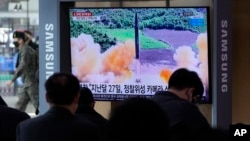Experts say the U.S. anti-ballistic missile system may be inadequate to defend against a new intercontinental ballistic missile (ICBM) under development by North Korea that could potentially carry multiple nuclear warheads.
"The current system right now would be quite constrained," said Ian Williams, deputy director of the Missile Defense Project at the Center for Strategic and International Studies. "Right now, the U.S. homeland missile defense system is tailored for fairly simple threats — one missile, one warhead, relatively simple countermeasures."
The United States announced Thursday that the missiles North Korea launched on February 27 and March 5 involved testing an ICBM system, the Hwasong-17, which Pyongyang showcased in a defense exhibition in October 2021.
A senior Biden administration official speaking on the background said the two launches did not demonstrate a full ICBM range. "These launches are likely intended to test elements of this new system before [North Korea] conducts a launch in full range," said the official.
"While the door remains open to diplomacy, the U.S. will take all necessary measures to ensure the security of the American homeland and our allies," the official added.
"The step up here to this new ICBM is its payload capacity," Williams said. The payload capacity is the total weight of warheads a missile can carry.
"It's perhaps the largest road mobile ballistic missile that we've seen in the world," he said.
"The purpose of it is to be able to carry multiple warheads."
US missile defense system
The Ground-based Midcourse Defense system, or GMD, the American missile defense system, is designed to intercept an inbound ICBM before it reaches the U.S. homeland. The GMD is in Fort Greely, about 100 miles southeast of Fairbanks, Alaska.
The Fort Greely Missile Defense Complex houses 40 of America's 44 anti-ICBM ground-based interceptors (GBIs), missiles that can destroy incoming ICBMs. It is much "like shooting the bullet with the bullet," said Bruce Bennett, an adjunct international/defense researcher at the Rand Corporation.
The other four interceptors are at Vandenberg Space Force Base near Lompoc, California Another missile field under construction at Fort Greely will hold silos for additional 20 GBIs.
But as it stands, the U.S. is equipped with 40 interceptors deployed to defend against ICBMs that would take approximately 40 minutes to travel from North Korea to the U.S. West Coast, Williams said.
The current U.S. missile defense capabilities are unable to defend against even one North Korean ICBM carrying a single nuclear warhead, according to a January report by the American Physical Society.
"Intercepting even a single nuclear-armed intercontinental-range ballistic missile or its warhead(s) in flight under the conditions expected during a nuclear attack is extremely challenging," the report said. "The ability of any missile defense system to do this reliably has not been demonstrated."
Challenge to missile defense
The U.S. missile defense system could fail if a North Korean ICBM carrying multiple nuclear warheads targeted the U.S., experts said.
The missiles North Korea tested in February and March could carry "between three to four" nuclear warheads, said Jeffrey Lewis, director of the East Asia Nonproliferation Project at Middlebury Institute of International Studies at Monterey.
They are larger than the ICBM tested in 2017. After that test, the U.S. assessed it would take about a year for Pyongyang to deliver a single nuclear warhead on an ICBM, but no nuclear warheads have been launched to date.
The Hwasong-17 ICBMs tested in February and March are up to 2.5 meters wide and weigh up to 110,000 kilograms when fully fueled.
By comparison, the three ICBMs North Korea tested in 2017 are estimated to be about 2.0 meters wide and 60,000 kilograms.
"The [U.S.] missile defense system [would be] shooting at four warheads instead of one, so there's a less probability of hitting them with accuracy," Lewis said. "You can overwhelm the system."
Usually more than one interceptor needs to be fired to target a single nuclear warhead, Bennett said.
"If you've got an ICBM carrying a nuclear warhead toward you, you're not going to fire just one of those interceptors because even a good design of an interceptor might have a 70% chance of working," he said.
"So you're going to fire at least two." Bennett said. "That means you can only deal with about 20 North Korean ICBMs. If each one has a 70% chance of working, roughly 10% of the North Korean warheads will get through."
If "half a dozen of these giant ICBMs" carrying multiple nuclear warheads are headed toward the U.S., "we simply run out of interceptors before we can get everything," Williams said.
According to Lewis, the elements of the new ICBM system that the U.S. said North Korea tested were attitude control devices or thrusters placed on a part of the missile called a payload bus, or post boost vehicle.
A payload bus is a missile structure that holds the propulsion and control system used to steer multiple reentry vehicles carrying warheads.
Lewis said the attitude control devices are dual usage devices, meaning they could be used for a nonweapon, such as a satellite, or an ICBM. "What it does, is it changes the attitude, or the angle at which the object is facing, so you can use it to point a camera" when a missile is used to launch a satellite.
He continued: "You would use attitude control thrusters [in the same way] to turn the bus around to drop multiple warheads on different targets."
North Korea said the tests in February and March were for developing a reconnaissance satellite.
VOA's Korean Service contacted the North Korean mission at United Nations to ask for its response to the U.S. conclusion that the country recently tested its ICBM system, but it did not receive a reply.










